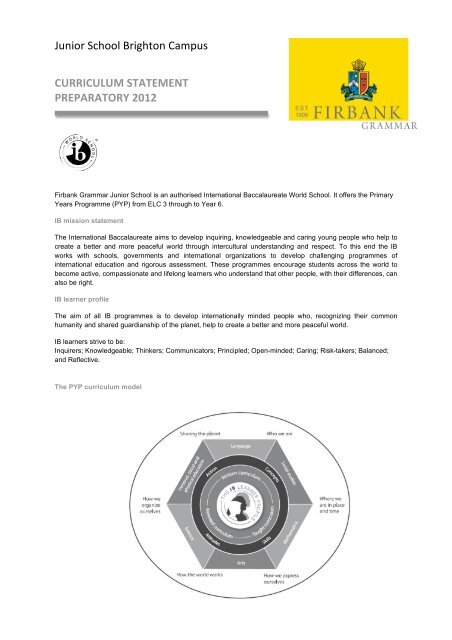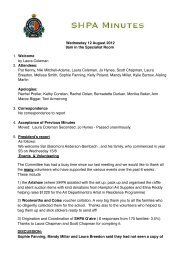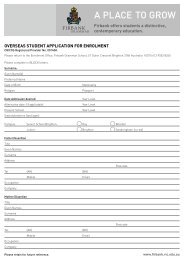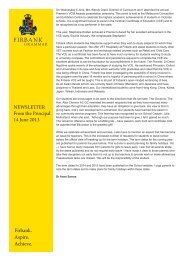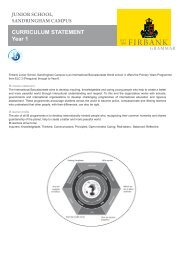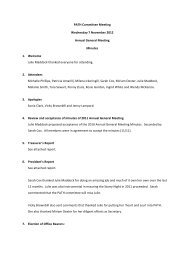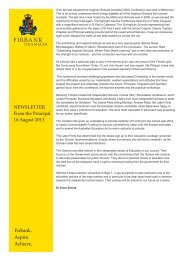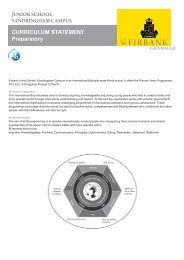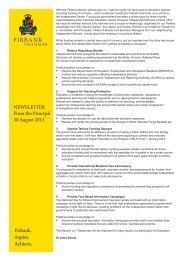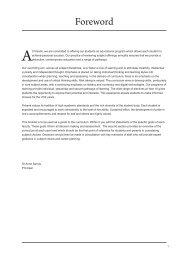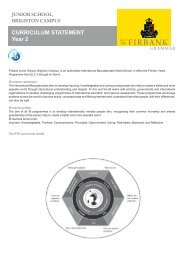Prep CS 2012 - Firbank Grammar School
Prep CS 2012 - Firbank Grammar School
Prep CS 2012 - Firbank Grammar School
Create successful ePaper yourself
Turn your PDF publications into a flip-book with our unique Google optimized e-Paper software.
Learning Subsumption Relations with <strong>CS</strong>R: A ClassificationbasedMethod for the Alignment of Ontologies 1Vassilis Spiliopoulos 1, 2 , Alexandros G. Valarakos 1 , George A. Vouros 1 , and Vangelis Karkaletsis 21 AI Lab, Information and Communication Systems Engineering Department, University of the Aegean,Samos, 83 200, Greece{vspiliop, alexv, georgev}@aegean.gr2 Institution of Informatics and Telecommunications, N<strong>CS</strong>R ”Demokritos”, Greecevangelis@iit.demokritos.grAbstract. In this paper we propose the "Classification-Based Learning of SubsumptionRelations for the Alignment of Ontologies" (<strong>CS</strong>R) method. Given a pair of concepts from twoontologies, the objective of <strong>CS</strong>R is to identify patterns of concepts’ features (here, properties)that provide evidence for the subsumption relation among these concepts. This is achieved bymeans of a classification task using decision trees. For the learning of the decision trees, theproposed method generates training datasets from the source ontologies’, considering eachontology in isolation. The paper describes thoroughly the method, provides experimental resultsfor computing subsumption relations over an extended version of the OAEI 2006 benchmarkingseries and discusses the potential of the method.Keywords: ontology alignment, subsumption, supervised learning, binary classification.1 IntroductionAlthough many efforts [1] aim to the automatic discovery of equivalence relations between theelements of ontologies, in this paper we conjecture that this is not enough: To deal effectively withthe ontologies’ alignment problem, we have to deal with the discovery of subsumption relationsamong ontology elements. This is particularly true, when we deal with ontologies whoseconceptualizations are at different “granularity levels”: In these cases, elements (concepts and/orproperties) of an ontology are more generic than the corresponding elements of another ontology.Although subsumption relations between the elements of two ontologies may be deduced by theequivalence relations of other elements, in extreme cases where no equivalence relations exist, thiscan not be done. In any case, we conjecture that the discovery of subsumption relations betweenelements of different ontologies may further facilitate the discovery/filtering of equivalence relations,and vise-versa, augmenting the effectiveness of our ontology alignment and merging methods [2].This paper presents the "Classification-Based Learning of Subsumption Relations for theAlignment of Ontologies" (<strong>CS</strong>R) method. <strong>CS</strong>R computes subsumption relations between conceptpairs of two distinct ontologies by means of a classification task, using decision trees, and byexploiting equivalences between properties. Given a pair of concepts, the supervised machinelearning method “locates” a hypothesis concerning their relation in a space of hypotheses, which bestfits (but not restricted) to the training examples [3], generalizing beyond them. Concept pairs arerepresented as feature vectors of length equal to the number of the distinct properties of source andtarget ontologies: Equivalent properties (i.e., properties with equivalent meaning) correspond to thesame vector component. The training examples for the learning method are being generated from thetarget and source ontologies.Although other features may be used, in this paper we study the importance of concepts’properties to assessing the subsumption between concepts: This is an important first step to assessingsubsumption relations among concepts, since (a) it appeals to our intuition about the importance ofproperties as distinguishing characteristics of classes of entities, (b) it makes the least possiblecommitment to the precision of any method for the discovery of equivalence relations amongontology elements, (c) it provides a basic method that can be further enhanced with other concepts’distinguishing features (e.g., concepts in a given vicinity), and can be further combined with other1 This work is part of research project ONTOSUM (www.ontosum.org), implemented within the framework ofthe “Reinforcement Programme of Human Research Manpower” (PENED) and co-financed by E.U.-EuropeanSocial Fund (75%) and the Greek Ministry of Development-GSRT (25%).
Programme of inquiry (POI)As far as possible all subject areas relate to the programme of inquiry. Over the course of a year, each grade levelcompletes six units of inquiry - one from each transdisciplinary theme.The <strong>Prep</strong> units of inquiry (UOI) are:Term 1 Term 1 & 2Transdisciplinary Theme: Where we are in place and time Transdisciplinary Theme: Who we areCentral Idea:Through journeys we discovermore about ourselves and theworld.Central Idea:Exploring humanrelationships helps us tounderstand differences.Lines of inquiry:• The types of journeyspeople make• Personal milestones• Changes experiencedbecause of a journeyLines of inquiry: • Family structures• Friendship• The way we communicateour family historiesConcepts Change, Reflection Concepts Function, ReflectionTerm 2 Term 3Transdisciplinary Theme: How the world works Transdisciplinary Theme: How we organise ourselvesCentral Idea:Understanding materials affectsdesign and construction.Central Idea:A process is needed to getproducts to people.Lines of inquiry:• The behaviour and uses ofmaterials• How materials affect designand construction• The manipulation ofmaterials for a specificpurposeLines of inquiry:• Where products comefrom• How people and systemswork together to makeproducts available• A variety of global systemsConcepts Form, Function Concepts Connection, CausationTerm 3 & 4 Term 4Transdisciplinary Theme: Sharing the planet Transdisciplinary Theme: How we express ourselvesCentral Idea:Living things live in differentplaces where their needs aremet.Central Idea:Imagination inspires us toexpress ourselves creatively.Lines of inquiry:• The characteristics of livingand non living things• Basic needs of living things• Our responsibility to preservehabitatsLines of inquiry: • How we can stimulate ourimagination• Ways we can express ourimagination• What it means to becreativeConcepts Form, Responsibility, Causation Concepts Connection, Perspective
For electronic browsing and ordering of this and other Manning books,visit http://www.manning.com. The publisher offers discounts on this bookwhen ordered in quantity. For more information, please contact:Special Sales DepartmentManning Publications Co.32 Lafayette Place Fax: (203) 661-9018Greenwich, CT 06830 email: orders@manning.com©2000 by Manning Publications Co. All rights reserved.No part of this publication may be reproduced, stored in a retrieval system, ortransmitted, in any form or by means electronic, mechanical, photocopying, orotherwise, without prior written permission of the publisher.Many of the designations used by manufacturers and sellers to distinguish theirproducts are claimed as trademarks. Where those designations appear in the book,and Manning Publications was aware of a trademark claim, the designations havebeen printed in initial caps or all caps.Recognizing the importance of preserving what has been written, it is Manning’spolicy to have the books we publish printed on acid-free paper, and we exert our bestefforts to that end.Library of Congress Cataloging-in-Publication DataConway, Damian, 1964-Object oriented Perl / Damian Conway.p. cm.includes bibliographical references.ISBN 1-884777-79-1 (alk. paper)1. Object-oriented programming (Computer science) 2. Perl(Computer program language) I. Title.QA76.64.C639 1999005.13'3--dc21 99-27793CIPManning Publications Co. Copyeditor: Adrianne Harun32 Lafayette Place Typesetter: Tony RobertsGreenwich, CT 06830 Cover designer: Leslie HaimesPrinted in the United States of America1 2345678910– CM – 02 01 00 99


